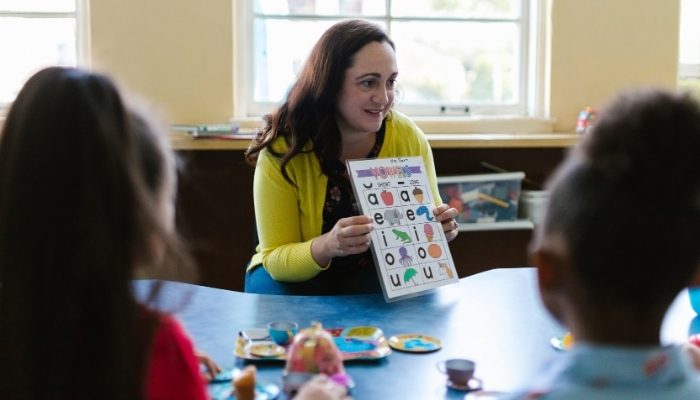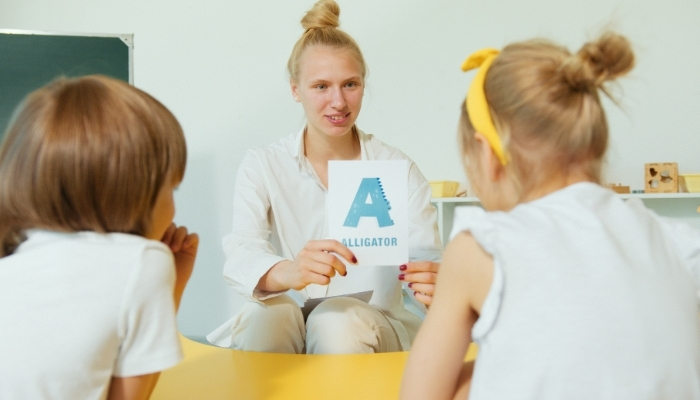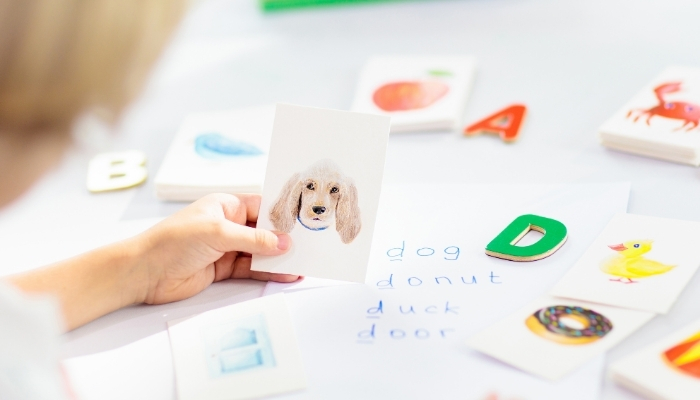You watch your child struggle with reading and wonder how you can help. Teaching your child to read might feel overwhelming, but phonics instruction provides a proven path forward. It helps children connect letters to sounds, giving them the foundation they need for lifelong literacy success.
Phonics instruction equips your child with the skills to decode new words on their own. Instead of memorizing every word, they learn patterns that unlock thousands of reading possibilities. Research indicates that children who receive explicit phonics instruction develop stronger reading skills, improved spelling abilities, and increased confidence in their learning.
This guide will walk you through everything you need to know about phonics instruction. You’ll learn what phonics instruction means, why it matters for your child, and how different teaching methods work. Most importantly, you’ll find practical ways to support phonics learning at home or at school.
Quick Overview
-
Phonics instruction teaches children the connection between letters and sounds, enabling them to decode unfamiliar words confidently.
-
Various phonics methods, like synthetic, analytic, embedded, and analogy approaches, support reading and spelling in different ways.
-
Structured strategies, combined with interactive activities, help children practice sounds, build words, and strengthen their reading fluency.
-
Following best practices and avoiding common pitfalls ensures children develop strong phonics skills while staying motivated and confident readers.
What is Phonics Instruction?

Phonics instruction teaches children the relationship between letters and sounds. It shows them how to blend sounds into words and decode new words independently. This foundational skill helps children read, spell, and recognize patterns in language, giving them the confidence to tackle any text with ease.
Core components of phonics instruction include:
-
Letter recognition and sound association.
-
Blending individual sounds into words.
-
Segmenting words into individual sounds.
-
Applying phonics patterns to spelling.
-
Reading words in context.
Phonics instruction also works in conjunction with other reading skills, such as vocabulary development and comprehension. The beauty of phonics lies in its transferability. Once your child learns that "ch" makes the /ch/ sound, they can apply this knowledge to read "chair," "church," and "chocolate" independently.
Also Read: Phonics vs Phonology: Understanding Early Reading Skills for Your Child
What are the Essential Principles of Phonics Instruction?
Effective phonics instruction is guided by a few core principles. These principles shape how children learn to connect letters and sounds while building confidence and independence in reading.
The Principle of Systematic and Explicit Instruction
Children learn best when phonics follows a clear, logical plan. Teaching sounds, letters, and word patterns step by step helps children see how words are built and reduces confusion. Direct instruction provides a roadmap for reading success.
Research from the National Reading Panel indicates that this approach yields significant gains in reading achievement (d = 0.41), with even stronger results (d = 0.56) when initiated in kindergarten or first grade, underscoring the impact of structured early instruction.
The Principle of Multisensory Learning
Engaging the senses of sight, sound, and touch reinforces learning. Tracing letters while saying the sound or using tiles and objects to build words strengthens memory and helps children make strong connections between letters and sounds.
The Principle of Immediate Application
Phonics skills become meaningful when children use them in real reading and writing. Applying letter-sound knowledge while reading books or writing simple words demonstrates to children how these skills are applied in everyday literacy.
The Principle of Gradual Progression
Start with simple sounds and words, then build to blends, digraphs, and multisyllable words. Gradually increasing difficulty helps children gain confidence, prevents frustration, and makes reading a skill they can manage independently.
Phonics instruction guided by these principles provides a clear framework for learning. Following them consistently gives children a strong foundation for reading and writing.
Types of Phonics Instruction

Different phonics methods exist, but the most effective approaches are always systematic and explicit. This means they follow a precise sequence and use direct teaching methods that leave nothing to chance. The most effective phonics programs are always systematic and explicit, following a clear, logical sequence and using direct teaching methods.
Here are the main types of phonics instruction and how they can support your child's reading development:
Synthetic Phonics
Synthetic phonics is a systematic approach that enables children to learn to connect letters with their corresponding sounds in a specific, logical order. They start with simple sounds and gradually build up to reading whole words.
With this method, you can help children blend individual letter sounds to form words. For example, they learn that “c-a-t” contains three separate sounds that come together to create “cat.”
Step-by-step synthetic phonics practice you can follow:
-
Start with single letter sounds (a, m, t, s).
-
Blend two sounds (at, am).
-
Move to three-letter words (cat, mat, sat).
-
Introduce consonant blends (st, br, cl).
-
Add vowel combinations (ai, ee, oa).
-
Practice multisyllable words (rabbit, garden).
This approach works well because it provides children with a clear, predictable method for decoding unfamiliar words, helping them build confidence and independence in reading.
Analytic Phonics
Analytic phonics starts with whole words and helps children identify sound patterns within them. Instead of blending individual sounds, children analyze complete words to understand how sounds work together.
You can introduce word families like “cat,” “bat,” “hat,” and “rat,” helping children notice the shared ending pattern and different beginning sounds.
Step-by-step analytic phonics practice you can try:
-
Present a group of similar words (big, bag, bug).
-
Help children identify common patterns.
-
Discuss how changing a single sound alters a word.
-
Practice reading new words with the same pattern.
-
Apply patterns to spelling activities.
-
Connect patterns to reading in books.
This method works well for children who learn better through pattern recognition rather than sound-by-sound building. By guiding children from whole to part, you can help them see connections in words and improve both reading and spelling skills.
Embedded Phonics
Embedded phonics is a type of phonics instruction where children learn letter-sound relationships naturally while reading meaningful texts, rather than through isolated drills and exercises. It integrates phonics teaching directly into stories and real reading experiences.
You can choose books that highlight specific phonics patterns and read them together to gain a deeper understanding. As children encounter target sounds, point out the letter-sound connections in context.
Step-by-step embedded phonics practice you can try:
-
Choose books with target phonics patterns.
-
Read the story together to understand its meaning.
-
Highlight specific letter-sound connections during reading.
-
Discuss the phonics patterns after reading.
-
Practice writing words from the story.
-
Apply new patterns to other reading materials.
This approach helps children connect phonics skills to real reading experiences, making learning more meaningful and engaging.
Analogy Phonics
Analogy phonics is a type of phonics instruction where children use known word parts to decode new words. For example, if they know “light,” they can apply this knowledge to read “night,” “fight,” and “sight.”
You can start with words children already know and introduce new words that share the same patterns. Highlight similarities between known and new words, helping children recognize consistent patterns across word families.
Step-by-step analogy phonics practice you can try:
-
Start with familiar words (make).
-
Introduce new words with the same pattern (cake, take, lake).
-
Compare known and new words side by side.
-
Practice generating word families together.
-
Use analogies to spell new words.
-
Apply patterns to reading new texts.
It's essential to note that choosing the right method will only help set the stage, but children need practical ways to apply these methods on a daily basis. The strategies mentioned below will turn phonics principles into hands-on learning that reinforces those patterns.
Also Read: Understanding Phonological Awareness and Development
Effective Phonics Instruction Strategies

Effective phonics instruction combines structured practice with interactive activities. Using research-backed strategies helps children master letter-sound relationships while applying their learning in meaningful, engaging ways.
-
Daily Sound Practice: Spend 5-10 minutes each day reviewing letter sounds with your child. Use flashcards, sound games, or quick verbal drills to reinforce learning. Consistent practice fosters automatic recognition, which supports fluent reading.
-
Word Building Activities: Use magnetic letters or letter tiles to build words together. Start with simple words and gradually increase complexity. This hands-on approach helps children understand how sounds combine to create words.
-
Decodable Books: Choose books that feature the phonics patterns your child is learning. These specially designed books give children successful reading experiences while reinforcing specific skills.
-
Sound Boxes: Draw boxes representing each sound in a word. Have your child move a counter into each box while saying the sound. This visual technique helps children segment and blend sounds more effectively.
-
Rhyme and Word Play: Use songs, chants, and games that emphasize sound patterns. Activities like "I Spy" with beginning sounds or rhyming games make phonics practice enjoyable.
-
Error Correction Strategies: When your child makes a mistake, guide them back to the correct sound gently. Say something like, "Let's look at that first letter again. What sound does it make?"
-
Word Mapping: Have your child identify each sound in a word, then match it to the correct letter or letter combination. For example, in the word "ship," they identify three sounds: /sh/-/i/-/p/ and map them to the corresponding letters.
A blend of structured strategies and your everyday technique will reinforce phonics learning and build reading confidence. When these strategies are used consistently, they build strong reading habits and boost confidence. Putting them into action helps children experience success with each new word they learn.
Also Read: How Kids Learn to Read in Kindergarten
Phonics Activities to Reinforce Learning

To strengthen phonics skills, it helps to combine structured practice with engaging activities. You can make phonics practice playful and hands-on, allowing children to apply their reading skills with confidence. Choosing age-appropriate activities reinforces key concepts while keeping practice enjoyable and engaging.
Here are some practical phonics activities organized by skill and age group:
Sound Recognition Games
Sound recognition games will help children recognize and remember letter sounds, a key step in learning to read. They make listening and speaking about sounds interactive and fun.
For Preschoolers (Ages 3-4)
-
Letter Sound Hunt: Hide plastic letters around the house. When your child finds a letter, they say its sound before seeing the next one. This builds letter recognition and sound association.
-
Sound Sorting: Use small objects like toys or snacks. Sort items by their beginning sounds into different containers. "All the /b/ sounds go in the blue box."
For Kindergarteners (Ages 5-6)
-
Musical Letters: Play music while your child walks around the letter cards. When the music stops, they pick up the nearest letter and make the sound it represents. Add actions like hopping for /h/ sounds.
-
I Spy Phonics: Play "I spy something that starts with /m/." This classic game builds phonological awareness while exploring your environment together.
For Early Elementary (Ages 6-8)
-
Sound Bingo: Create bingo cards with letters instead of numbers. Call out sounds and have children cover the matching letters. This builds quick sound-letter recognition.
-
Phonics Telephone: Whisper a word to your child. They segment the sounds and whisper them to the next person, who blends them back into the word.
Word Building Activities
These exercises demonstrate how letters combine to form words, helping children understand spelling patterns.
For Preschoolers
-
Play-Doh Letters: Roll Play-Doh into letter shapes while saying each letter's sound. This multisensory approach strengthens memory through touch and movement.
-
Letter Stamps: Use alphabet stamps and ink pads to create sound patterns. Stamp all the letters that make the /s/ sound, then move to the next sound.
For Kindergarteners
-
Magnetic Word Building: Use magnetic letters on the refrigerator to build simple words. Start with three-letter words and celebrate each success with enthusiasm.
-
Word Ladders: Change one letter at a time to create new words. Start with "cat," change the /c/ to /b/ for "bat," then change /a/ to /i/ for "bit."
For Early Elementary
-
Word Family Houses: Draw houses and write word families on the roof (-at, -an, -ip). Fill each house with words that belong to that family.
-
Syllable Clapping: Clap out syllables in multisyllable words while building them with letter tiles. This helps children understand word structure.
Reading Aloud Sessions
Read-aloud sessions let children hear correct sounds and rhythms while practicing comprehension and expression.
For All Ages
-
Echo Reading: Read a sentence aloud, then have your child repeat it with the same expression and pacing. This builds fluency and prosody.
-
Partner Reading: Take turns reading pages in a book. Select books that are slightly below your child's independent reading level for confident and successful reading.
-
Character Voices: Create different voices for book characters. This makes reading engaging while building comprehension and expression skills.
Rhyming and Onset-Rime Games
Rhyming and word patterns help children notice and play with sounds. This skill supports both reading and spelling.
For Preschoolers
-
Nursery Rhyme Actions: Add movements to familiar nursery rhymes. Clap on rhyming words to emphasize sound patterns.
-
Rhyme Time: Name two words and ask if they rhyme. Start with obvious pairs, such as "cat/hat," before moving on to trickier combinations.
For Kindergarteners
-
Rhyming Bag: Fill a bag with small objects. Pull out two items and decide if their names rhyme. This builds phonological awareness skills.
-
Word Family Wheels: Create spinning wheels with onsets and rimes. Spin to create real and silly words while discussing which combinations work.
For Early Elementary
-
Rhyming Stories: Write short stories using as many rhyming words as possible. Read them aloud together and laugh at the silly combinations.
-
Poetry Writing: Help your child write simple poems using familiar rhyming patterns. This combines phonics practice with creative expression.
Writing and Spelling Exercises
Writing and spelling demonstrate to children how sounds correspond to letters. These activities give hands-on practice with phonics patterns.
For Preschoolers
-
Sand Writing: Pour sand into a shallow pan. Let your child trace letters with their finger while saying the sound. This sensory experience strengthens learning.
-
Rainbow Writing: Write letters with different colored crayons, tracing each letter multiple times to create a rainbow effect.
For Kindergarteners
-
Sound Journals: Keep a notebook where your child writes letters and draws pictures of objects that start with each sound.
-
Invented Spelling: Encourage your child to spell words the way they sound. Accept approximations and celebrate their thinking process.
For Early Elementary
-
Word Sorts: Write words on cards and sort them by spelling patterns, vowel sounds, or number of syllables. This builds pattern recognition.
-
Spelling Stories: Use weekly spelling words to create short stories. This will help your child remember spellings through meaningful contexts.
These activities create positive associations with phonics learning while building essential skills. Remember that every child learns at their own pace, so adjust activities to match your child's interests and abilities.
The Do's and Don'ts of Phonics Instruction

Knowing the right approach to phonics helps your child learn to read accurately and confidently. Following proven practices will prevent mistakes that slow progress or cause frustration.
In this section, you will learn what actions to take and which to avoid so you can guide your child to recognize sounds, blend words, and build strong reading skills.
Do's
-
Focus on systematic progression, start with simple letter sounds, and gradually introduce more complex patterns such as vowel combinations. Following a logical sequence helps your child build skills steadily.
-
Make learning multisensory by using different senses during phonics practice. Have your child trace letters while saying sounds, manipulate colored tiles, or move while playing sound games.
-
Provide explicit instruction to teach phonics concepts directly, rather than expecting your child to figure them out on their own. Show how to blend sounds, form letters, and understand spelling rules clearly.
-
Practice daily, keep sessions short and consistent. Spending 10-15 minutes each day helps your child retain skills and build automatic responses.
-
Connect phonics to real reading by reading books together and pointing out target sounds. Encourage your child to decode words independently and celebrate each success they achieve.
-
Celebrate small wins, recognize progress, and acknowledge even the smallest steps. Positive reinforcement builds confidence and encourages continued learning.
Don'ts
-
Don't rush the process and allow your child to learn at their own pace. Pushing too fast can create anxiety and slow progress.
-
Don't rely solely on worksheets, as they should not be the primary learning tool. Include interactive and hands-on activities to make phonics enjoyable.
-
Don't ignore individual learning styles and observe how your child learns best. Visual learners benefit from seeing patterns, while kinesthetic learners need movement and tactile experiences.
-
Don't skip phonological awareness and make sure your child can hear and manipulate sounds before focusing on letter-sound relationships. Activities like rhyming and clapping syllables build a strong foundation.
-
Don't forget about meaning and encourage comprehension along with decoding. Talk about what you read together and connect phonics practice to real reading experiences.
-
Don't compare children because every child develops at their own pace. Avoid comparisons that create pressure or anxiety.
Following the right approach makes learning easier and more enjoyable for your child. With guided programs that apply these practices, children can build their reading skills in a supportive environment.
Also Read: Kindergarten Reading Tips for Parents
How FunFox Supports Phonics Learning?

FunFox helps children build a strong phonics foundation through programs that combine systematic instruction with engaging, hands-on activities. Children learn to recognize sounds, blend words, and apply skills in reading and writing.
In the Writers Club, children practice phonics through writing. They segment sounds when spelling and blend them while reading their work aloud, strengthening decoding and encoding skills.
The Readers Club focuses on decoding and fluency. Children apply phonics patterns while reading stories, connecting skills to real reading experiences and gaining practical literacy confidence.
FunFox programs meet each child’s individual needs. Small class sizes allow teachers to give personalized attention. Lessons use visual, auditory, and hands-on activities to support different learning styles.
Key Features of FunFox Phonics Instruction
-
Tailored Learning: Lessons adjusted to match the child’s pace and style.
-
Interactive Practice: Games and activities make phonics enjoyable and memorable.
-
Parent Progress Updates: Clear insights and tips to support learning at home.
-
Structured and Flexible Instruction: Children receive systematic guidance while exploring reading and writing in a natural and engaging way.
-
Confidence Building: Lessons reinforce skills while maintaining a positive and engaging learning experience.
With FunFox, your child develops strong phonics skills, reading confidence, and a genuine interest in literacy, guided by teachers trained in evidence-based methods.
Wrapping It Up
Phonics instruction provides your child with essential tools for reading success. When children master letter-sound relationships and blending skills, they become independent readers who can approach new books with confidence.
It is evident from multiple studies that systematic, explicit phonics instruction benefits children across different backgrounds and ability levels. Starting early provides your child with the strongest foundation, but quality instruction can also support struggling readers at any age.
Phonics is one part of the reading puzzle. Decoding skills work best when paired with vocabulary development, comprehension strategies, and plenty of meaningful reading experiences.
Your involvement at home makes a big difference. Programs like FunFox combine systematic phonics instruction with engaging activities, giving your child both the skills and confidence to enjoy reading and writing. Experienced teachers guide each child in ways that make phonics learning clear, hands-on, and fun.
Take the next step in your child’s reading journey. Book a free trial class for FunFox’s Writers Club or Readers Club and watch them gain the skills and confidence to tackle any book.
FAQ’s
1. What is a phonics instruction example?
A teacher shows the letter “b” and its sound /b/. Children find objects that start with /b/ and blend them with other sounds to form simple words like “bat.”
2. What are the five skills of phonics?
Phonics skills include recognizing letter sounds, blending sounds to form words, breaking words into sounds, applying spelling patterns, and reading words in sentences. These help children improve decoding and fluency.
3. What are the seven steps of the phonics process?
The steps are learning letter sounds, blending sounds into words, segmenting words, spotting patterns, practicing reading, spelling with sounds, and applying phonics through writing activities to reinforce learning.
4. How to teach phonics step by step?
Start by teaching letter sounds, then blending them into words. Next, help children segment sounds, introduce patterns, and use reading material that reinforces phonics skills in real contexts.















